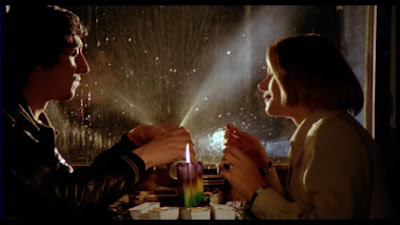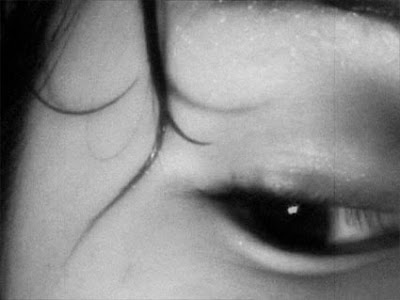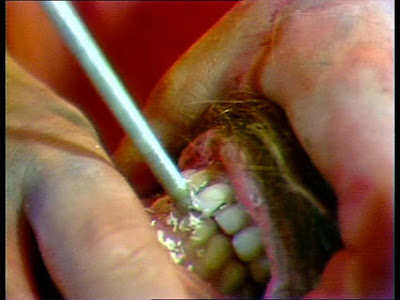Night Train Murders
Original Title: L’ultimo treno della notte
Directed by: Aldo Lado
Italy, 1975
Thriller, Rape/revenge, 94min
How could the late
Ulla Isaksson ever have know that the
script she based on a century old folksong, later directed by
Ingmar Bergman as
Jungfrukällan (The Virgin Spring) 1960, would end up being a prime source for
exploitation films? Did she ever know? Did anyone ever inform her of this?
Wes Craven hit it off when he loosely based his Last House on the Left 1972 on
the Isaksson script, and the ball was set in motion. Movies that sometimes
where inspired by the plot, sometimes by the title such as Last House on Dead
End Street, 1977, La settima donna (Last House on the Beach) 1978, to some
extent Autostop rosso sangue (Hitch-Hike), 1977, and even Mario Bava’s Reazione
a catena (Bay of Blood) was labled Last House on the Left, Part2 when it was
finally released in the USA pooped up all over the place. Most of the films drew inspiration from the Craven
movie and it’s spawn, and perhaps most famously Ruggero Deodato’s House at the
Edge of the Park 1980. But already in 1975, Aldo Lado and Renato Izzo wrote a
screenplay based on a story of Roberto Ifanascelli and Ettore Scanó
(responsible for several similar stories) came up with Last Stop on the Night
Train, also known as Night Train Murder.

Laura Stradi [Marina Berti] and cousin Margaret Hoffenbach
[Irene Miracle later to star in Dario Argento’s Inferno 1980] are on their way
home for the holidays. The two girls take the train from Munich with Laura’s hometown
in Italy as the final destination. But fate has other plans for them, and they
never get there... On-board the train they encounter two brutish thugs; Blackie
[Flavio Bucci also seen in Argento’s Suspiria 1977] and Curly [Gianfranco De
Grassi] team up with the seedy blonde know only as “the lady” [Macha Mérli, best
known for her performance as the psychic Helga Ullman in Argento’s Profondo
Rosso (Deep Red) the same year, 1975] and set a series of sordid games in motion
that lead up to the death of the two young women. Following the deaths the three end up at the
home of Professor Guilio Stradi [Enrico Maria Salerno – Inspector Morosini in
Argento’s debut feature L’uccello dale piume di cristallo (The Bird with the
Crystal Plumage) 1970] and his wife Lisa [Laura D’Angelo] who soon realize who
they have encountered and take a violent revenge.
Night Train Murders could more or less be looked at as a
chamber piece, as it mostly takes place in one location, apart from the last
act. This startling thriller is simply fascinating from the opening titles with
that dodgy vocal song, but more on that later, to the final shot. Because this
is a well plotted, well-written and definitely surprising film. The movie is like a jigsaw puzzle where each
part interlocks with the next brining a larger image together. As I say, this
is a well-plotted, well-written gem, and now I’ll tell you why!
Already during the opening titles the threat of Blackie [Bucci] and
Curly [DeGrassi] is presented as they who run
around Munich, stealing, roughing people up, and even robbing a drunk Santa of
his few pennies before freeloading onto a train in the station. These guys,
despite being stereotypical villains for Italian genre film of the time, are definitely
trouble to count on for hell raising.
Six minutes in, the set up for a later twist is presented.
The overprotective parents are presented through a series of phone calls to the
maid who just put Laura [Berti] and Margaret [Miracle] on the train home, and Prof. Stradi [Salerno], who
obviously spends his days saving the lives of people – on his way home to his
wife, he stops in the corridor as he hears two colleagues talk about the
unfortunate accident victim who’s life can’t be saved. The honourable Prof. Stradi hands his briefcase to the nurse and tells them to call his wife and
tell her he’ll be late… a presentation of traits that later will collide, and
become of importance to the story.

The introduction of “the Lady on the Train” [Mérli] is
an interesting one. Only moments after she enters the full train carriage and
giving off an aura of a sophisticated lady – later enhanced when she discusses
politics with the famous politician she recognizes in the newspaper to be
sitting across from her in the carriage - she accidentally drops her purse as
the train shakes through an intersection. The only item that gives any form of
identification of her person is seen after the contents spill out, is a sordid
photograph of a group sex session. Alberto Galittini’s edits of the carriage
passengers looks at Mérli is magnificent, as it taints every scene between Mérli
and the co-passengers in that confined space from there on. It also indicates
that the posh lady is not quite what she seems behind that strict facade. Also it’s
no surprise that the scene is placed directly after the carriage of priests and
bishop is presented. Contrasting the passengers in this way is a metaphor of
heaven and hell, good and evil, and pretty soon this comes to ring disturbingly
true.

The girls are somewhat innocent kids, giddy to be away from
school, smoking way to many cigarettes and exploring their sexuality – “Try
leaning against the wall, you get a great feeling from all the vibration. Go
on, try it!” Margaret says to Laura who answers “Yeah you are right. You think
of everything.” This dialogue too is significant, as flirtation, forbidden
pleasures and sexual tension is an important part of the set up. The old saying curiosity killed the cat comes
to mind.

Margaret confides in Laura, her first and only sexual encounter,
they pleasure themselves by the vibration of the train. Margret has a brief but
daring flirt with the thugs in the train restroom, which leads to the Blackie forcing
his way in with “The Lady” when she goes to the restroom, and the sexual
tension between the two leads to them having intercourse… with, believe it or
not, cutaways of the train entering tunnels and rail tracks. Again this is all
presentation of character, Blackie is a ruthless predator who won’t take no for
an answer, and with the photograph and fact that she’ll shag strange blokes in
the train crapper, and we understand that “The Lady” is a lurid character.

After changing trains, the girls are confronted by Curly and
Blackie again, this time The Lady comforts them with the words that she won’t
let them harm them. Now if they had stayed on the other train, the one filled
with businessmen, politicians and the clergy, we may have believed her, but as
soon as she says this, Lado takes us on a quick tour of this new train’s
passenger. Prostitutes, Peeping Tom’s and Junkies… this is a completely
different ride, as mentioned above, polarization is the game, and here it’s
school bock example. In it’s finest form as the girls, held captive in the seedy
night train, by Curly, Blackie and The Lady try to make a run for it, when
Blackie beats Margaret… as she falls into the glass of the dark carriage door, editor
Gallitti rapidly inserts shots of the light happy Christmas dinner taking place
at their destination. Keep an eye open for Dalia di Lazzaro, from Andy Warhol’s
Flesh for Frankenstein 1973, and Dario Argento’s Phenomena 1985 during this
dinner party. Later Gallitti does the same when Margaret’s parents dance whilst
their daughter is being raped. As
mentioned earlier, contrasts play a big part in this movie, and here’s it’s
presented in it’s finest form.

Within the dark confined space - superbly light and captured
buy cinematographer Gábor Pogány who also shot Pink Floyd: Live at Pompei 1972
- tension builds, as Curly, Blackie and The Lady start off a series of sadistic
games, sexually themed torments and rapes, that not only had the BBFC’s refuse
to give the film a cinema certification in 1976, and landed the it on the list
of banned video nasties back in 1983, but also arrives at a shocking climax leaving
both the young girls dead. This hideous act propels us into the final act.
In accuracy with the original Isaksson source, the criminals
arrive at the home of the victim’s parents, and as an audience we are now
craving vengeance. It’s really not too complicated; once again we have an emotional
recognition. We can’t experience what the girls or their parents do, but we
want justice for the wring done to them.
This is where the subplot with the parent’s fading relationship
and the new start this Christmas has brought hem, along with the previous
establishment of their good character come into play. Blackie, Curly and The
Lady, get off the train instead of the girls, The Lady with injuries obtained
as Blackie beat her after the murders, is offered to come home to the ever
gallant Prof. Stradi to have her wounds taken care of as his wife and he await
the next train to arrive. Here the traits that where established early on come
back into play, Stradi’s lack of to refuse tending to patients end up with him
taking the trio of strangers home.

Then a streak of genius by the scriptwriters... a scene that
earlier seemed to be random, falls into the jigsaw, making the fuller picture
come into focus for the Stradi’s. During the opening of the movie we saw a scene
where the maid who sends Lisa and Margaret to the train station on their trip
home, calls Lisa, Laura’s mother, and warns her of the terrible turquoise neck
scarf Lisa has bought for her father as a Christmas present. Curly steals this
necktie as they toss the girls bodies and belongings off the train, and Mrs.
Stradi quickly becomes suspicious of the strangers in her house. The frequent
newsflashes on the radio finally reveal the identity of the two dead women
found mutilated by the side of the railroad tracks, and Dr. finally snaps. To
hell with moral, and common sense, emotions get the upper hand and he takes his
vengeance on the thugs. The journey is complete, from respected, caring, kind-hearted
man of society to cold-hearted avenger, outside the law. Just as in the Ulla
Isaksson script, the question of how far would you go, what would you do, could
you kill if you had the chance are posed. Harrowing questions that make the
Bergman movie such a classic and poignant themes that ring true through the
most of the imitations that came in it’s wake.

OK, so a few words on the soundtrack, because despite having
something of a crap start with Demis Roussos garbing his way through “A Flower
is All you need” – originally the theme song to a romantic themed animated film
Il giro del mondo degli innamorati di peynet (Around the world of Love) from
1974 – Night Train Murders has a rather interesting soundtrack. Diegetic audio
is of importance, as the sound of the train mainly plays as the movies
soundtrack together with Morricone’s minimalistic score. But also non-diegetic audio
is used to create effect. At times entire scenes off the train, inside the
mansion of the Stradi’s are acted out without the correct audio. Instead we
only hear the sound of the train rushing forth towards its destination. It keeps a tension whilst showing us the contrasts,
which I talked about earlier.
Harmonica is an important part of this soundtrack, as Curly frequently
plays one. It also becomes an important signifier that the “Crazy Boys” also
change trains when Lisa and Margaret do so at a border check earlier on.
Certain that they alone in the new coach they have snuck into, they share a
Spartan Christmas dinner of sandwiches and pop – kids once again – when they
suddenly hear the warble of Curly’s harmonica. It’s a disturbing moment, as
they react with honest fear… the crazy boys are there.
Night Train Murders still holds up, it’s a tight, tense and
fairly sleazy piece that definitely is worth enjoying if you still haven’t seen
it. A enthralling ride that takes some dark turns, and forces the audience to
drop their morale and find their primitive being confined deep inside. Now available in it's uncut glory, with a new superior image, remastered in 1.85:1 and presented with crisp DolbyDigital 2.0 Mono from
Shameless Screen Entertainment.
 A documentation of war crime atrocities conducted by Japanese
Unit 731 during the Second World War. A harrowing brew of archival footage, re-enactments
and interviews with Anatoly Protasov, who was a former doctor/ military
translator at the trials of the U731 doctors in Khabarovsk, USSR at the end of
WWII.
A documentation of war crime atrocities conducted by Japanese
Unit 731 during the Second World War. A harrowing brew of archival footage, re-enactments
and interviews with Anatoly Protasov, who was a former doctor/ military
translator at the trials of the U731 doctors in Khabarovsk, USSR at the end of
WWII. Philosophy of a Knife get’s 6/6, and that’s for the approach to the subject matter and sheer enormity of this movie. Although there are some minor flaws, which in all
honesty would be like complaining about the tan marks on the nuns in eighties
nunsploitation flicks, or sock marks on nude inmates in WI.P films, the film is
still totally worth the full house. Damn, four hours plus of vile grimness,
interwoven with an important historic story. This is potent stuff. Just after
Iskanov had completed postproduction, and had shipped his cut/footage to US for
the DVD release, he was obtained by the FSB - that’s KGB to you and me mate!
His computer and materials where seized and he was continuously interrogated on
the source and extent of his research. After being held captive in a military
base prison cell for five days, Iskanov was released with little of his
materials or computers given back. I’d would have written it up as a genius
marketing gimmick if I didn’t know that, one of the ballsiest Swedish movie
distributors, have been trying to get this movie out for over a year now. More than one hard drive has been seized by officials on the way between
Iskanov and the distributor. Or the fact that the box of discs I once sent my
mate Alex in Russia, never arrived at his place either! One wonders what they
where afraid Iskanov may have found…?
Philosophy of a Knife get’s 6/6, and that’s for the approach to the subject matter and sheer enormity of this movie. Although there are some minor flaws, which in all
honesty would be like complaining about the tan marks on the nuns in eighties
nunsploitation flicks, or sock marks on nude inmates in WI.P films, the film is
still totally worth the full house. Damn, four hours plus of vile grimness,
interwoven with an important historic story. This is potent stuff. Just after
Iskanov had completed postproduction, and had shipped his cut/footage to US for
the DVD release, he was obtained by the FSB - that’s KGB to you and me mate!
His computer and materials where seized and he was continuously interrogated on
the source and extent of his research. After being held captive in a military
base prison cell for five days, Iskanov was released with little of his
materials or computers given back. I’d would have written it up as a genius
marketing gimmick if I didn’t know that, one of the ballsiest Swedish movie
distributors, have been trying to get this movie out for over a year now. More than one hard drive has been seized by officials on the way between
Iskanov and the distributor. Or the fact that the box of discs I once sent my
mate Alex in Russia, never arrived at his place either! One wonders what they
where afraid Iskanov may have found…?





















































